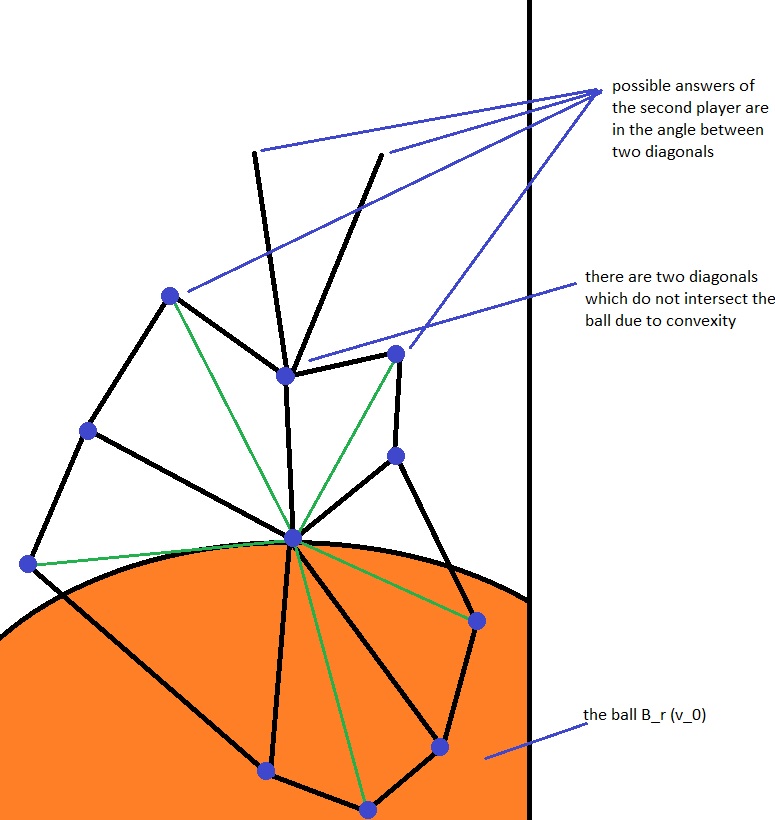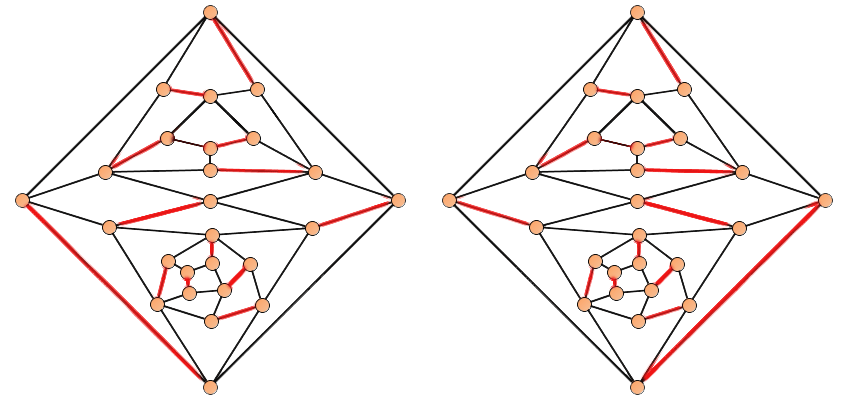I think the answer is "yes" for such quadrangulations that at least $4$ squares meet up in each inner vertex.
Snake game lemma
Consider the following game. We are given a planar graph $G$ with boundary being one cycle (called outer cycle $\partial G$). First player chooses a vertex on a boundary and then picks a neighboring vertex (not on a boundary).
The game proceeds as follows: players take turns moving the chosen vertex along the edges. They can not visit vertices which were already visited.
The goal of the first player is to move the chosen vertex to the outer cycle (on their turn). The second player is not allowed to move to the outer cycle, and wins if the first player can not take a turn.
If the second player can not take a turn, the draw is called (this case will not be important in the application)
Note. For a square-tiled region on a plane the first player has an obvious strategy - always go up.
Proposition Suppose the graph is quadrangulated and $2$-colored, and also that in every vertex at least $4$ squares meet up. Then, the first player has a non-losing strategy.
Proof Put a metric structure of a surface with conical singularities on a disk in such a way that every square is an actual euclidean square with the side $1$. It is a space of non-positive curvature (CAT(0) space).
Fact the ball of radius $r$ in CAT(0) space is always strictly convex.
This is true because of the comparison triangle with the plane.
Strategy of the first player. The first player should at every turn attempt to increase the distance from the initial vertex $v_0$ on the boundary they started on. Consider the collection of squares meeting up in a vertex $v$ which is on a distance $r$ from $v_0$. The ball $B_r(v_0)$ intersects interiors of at most three squares neighboring each other (due to being convex). It means that first player can take a turn which increases the distance function.
Consider the set of diagonals emanating from the vertex $v$. Any two neighboring diagonals have the angle $\frac{\pi}{2}$ between them, so there exist two such neighboring diagonals that they are not contained in $B_r(v_0)$ (for the same reason - the directions such that the ray in this direction intersects $B_r(v_0)$ form an angle of at most $\pi$ due to the ball being convex).
Now, the first player should take turn along the edge which is contained between two such neighboring diagonals. Then, the second player can respond with two turns "the rightmost one" and the "leftmost one" which lead them to the ends of these diagonals (and hence the distance to the vertex $v_0$ be increased), or take any of the edges inbetween, which also won't lie in $B_r(v_0)$ due to convexity.
By following this strategy, the first player will increase the distance function every turn, hence has no chance at meeting the vertex the have already met at all and will eventually end up on a border.
Note. I believe for the quadrangulations of positive curvature the second player should typically win, but I had not prove it.

Global move lemma
Consider a graph $G$ as above. Suppose we fix a perfect matching of internal vertices (it is "frozen"). Then the two ways of perfect matching of this graph are connected by local moves (which will unfreeze the internal part of the perfect matching and then freeze it back). This operation will be called "global move".
Proof: let us call the vertices which are edge distance $1$ from the outer cycle "neighboring". We are going to find the path (inside the frozen part) between the neighboring vertices which is perfectly matched.
Let us play a Snake Game, starting from any vertex in the boundary, where the first player plays according to the non-losing strategy above, and the second player (who receives the vertex $v_i$) always picks the vertex which is matched with the current position. The draw case is not possible, because second player always has a correct turn.
So, the produced sequence of vertices will form a path of even length which is perfectly matched. It separates the disk into two parts. One of these parts admits the global move, and other will admit after we do the first global move (both can be done by induction hypothesis).
Composition of such moves will be a global move of the whole graph.
Local move connectivity
Consider a pair of dimer configurations on a graph. Their difference is a union of non-intersecting cycles (this is clear and seems to be very classical).
Let us proceed by doing global moves along these cycles.
$\blacksquare$
And now some notes on height functions. Consider the dual graph $T$ of our planar graph. Then, we have facets of $T$ colored in two colors. Consider the following (discrete) $2$-form $\alpha$: it takes value $+1$ over black facets and $-1$ over white facets.
The height function is constructed as follows: we need to find discrete $1$-form $\beta$ such that $d\beta = \alpha$. Then, integral of $\beta$ over the boundary of 2 neighboring facets is $0$, and integrating over the boundary of our tiles gives us the height function. It is always possible by Poincare lemma
The height function approach will work if the form $\beta$ satisfies the following positivity condition: for every edge $s$ oriented counterclockwise along the black facets $\beta (s) > 0$.
Important example is if our graph $G$ was $k$-regular (which means dual graph $T$ has only $k$-gonal dual facets). Then, the form can be taken $1/k$ on every edge (with orientation described above).
Then, if this positivity condition is fulfilled, the possible vertices for local moves will be exactly local minima and local maxima of height function (check it!)
Thurston proceeds doing local moves untill all local maxima in the interior of the tiling are removed, and then proves that the matching such that it has no local maxima in the interior is unique - by finding the maximum of the height function on the boundary and checking that it is unique near it and proceeding by induction. The argument transitions well (it is another simple check).
The question is how does one find such form $\beta$. I've tried using Hodge theory, but it didn't seem to be too successful.






